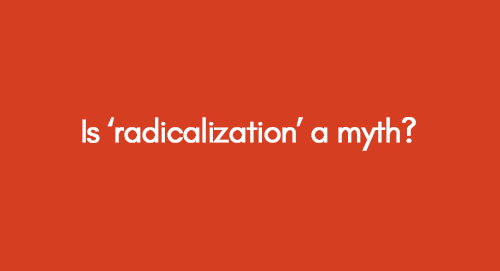
The Influence of Social Networks on Online Purchasing Behavior of Consumers in the UK
July 6, 2022
Emotional Intelligence (EI) and Interpersonal Skills (IPS): The Moderating Role of Attachment Style (AS)
July 6, 2022In questioning the prevailing narratives, this exploration dives into the provocative inquiry: Is Radicalization a Myth? Unraveling layers of perception and reality, it navigates the complexities surrounding radicalization to discern the truth within the discourse.
In recent years, the term 'radicalization' has gained significant prominence in discussions surrounding terrorism, extremism, and political violence. It has become a key concept to help us understand how individuals become involved in extremist or violent movements. The concept of radicalization suggests a series of steps or stages that individuals go through, ultimately leading them to adopt radical beliefs and engage in acts of violence. While it provides a useful framework for analyzing and addressing the problem of extremism, it has also come under scrutiny by some who question its validity and argue that it may be an oversimplified narrative.
Learn More About Radicalization
Explore More About Radicalization
These sceptics suggest that radicalization might be a myth or, at the very least, a framework that oversimplifies the complexities involved in the process. They argue that it can inadvertently stigmatize certain communities or individuals and create a one-size-fits-all approach to a multifaceted issue. In this blog, we will delve into radicalization, examine some common myths associated with it, and shed light on the intricate and nuanced factors that contribute to individuals' involvement in extremist or violent movements. Doing so, we hope to foster a more comprehensive and informed dialogue about this critical issue in our contemporary world.
Introduction
The roots of radicalism trace back to its early forms, notably during the French Revolution, which subsequently influenced similar movements in countries worldwide. The concept of radicalism gained significant prominence in the early 1830s, primarily in the United Kingdom and Belgium. As it progressed, radicalism expanded across Europe during the 1840s and 1850s, according to Vidino (2010). Notably, during these historical periods, radicalism was primarily associated with a movement striving for political legitimacy and progressive reforms in the electoral system, emphasizing the pursuit of profound political change.
Radicalism was closely linked with ideas of civic nationalism, republicanism, the abolition of noble titles, and resistance against establishing a state religion. Over the 19th century, radicalism evolved into a formidable political force. In France, radical politicians gained prominence in the parliamentary arena and went on to create the first major extra-parliamentary political party in the country. The Republican party, a Radical-Socialist Party, assumed a central role in government affairs between 1899 and 1940, as outlined by Vidino (2010).
As social democracy emerged as a distinct political force, the traditional gap between left-wing radicalism and conservative liberalism began to narrow. Over time, radicalism waned in relevance across much of Europe, ceding its place to conservative-liberal and social democratic parties. Radicalism can also be viewed as an extreme or resolute variant of liberal reformism. This interpretation situates radicalism along a political continuum that ranges from right-wing reactionaries to left-wing liberals, with various expressions encompassing mainstream populism and middle-class liberalism, as described by Calhoun (2012).
Leading Pathways to Radicalisation
The process of radicalization unfolds along various interconnected pathways, where these routes tend to intensify the grievances of individuals or groups by amplifying radical ideologies, motivating them to pursue political goals (Aly and Striegher, 2012). These factors can be broadly categorized into individual-level, group-level, and mass radicalization factors. Individual-level factors encompass personal grievances, loyalty, risk tolerance, and the pursuit of status (Jensen et al., 2018). Group-level factors involve dynamics such as isolation, polarization, and competition. Mass radicalization, on the other hand, includes elements like Jiujitsu politics and the fomentation of hatred.
Personal grievances hold particular significance in driving individuals toward violent actions, often compelling them to seek revenge for perceived wrongs. In addition, group grievances play a critical role in fueling ethnic or political violence, with instances such as suicide bombings being linked to these grievances (Vidino, 2010). Some experts argue that the aftermath of the 9/11 attacks, coupled with the suspicion and animosity directed at Muslims residing in Western countries, as well as the indignities they faced from security authorities, can be seen as factors contributing to the radicalization of recruits (Trip et al., 2019). Furthermore, the 'Us versus Them' perception exemplified by Donald Trump's travel ban significantly impacted Muslim immigration to the United States (Maltz, 2018).
Loyalty can serve as a powerful bond among individuals or groups, rallying significant support from their followers. This phenomenon is evident in the New Left radical movements, including the German Army Faction and the American Weather Underground. Notably, the strong relationships between figures like Bill Ayers and Bernardine Dohrn, Andreas Baader and Gudrun Ensslin were crucial in serving as organizational nuclei connecting these groups (Trip et al., 2019).
The loss of such connections can render individuals susceptible to unfamiliar ideas and new identities, potentially leading to political radicalization. This process of "unfreezing" exposes individuals to isolation from their social circles, including friends and family, along with insufficient access to necessities, increasing the likelihood of them joining radical groups, whether of cultural, political, or religious nature. It's essential to highlight that isolation can potentially reinforce radical thinking. Furthermore, competition within a group can drive them toward radicalization, particularly when competing for legitimacy and prestige among the broader population (Jensen et al., 2018). Undoubtedly, radicalization encompasses diverse pathways that often result in distinct outcomes, with these pathways serving as conducive conditions for the transition from radicalization to eventual engagement in violent actions.
Types of Radicalisation
Radicalization is an ongoing process involving cognitive and behavioural shifts, highlighting how individuals evolve their beliefs and actions over time (Calhoun, 2012). This dynamic nature introduces uncertainty and diversity into the various interpretations of radicalization, shaping the theoretical discussions that explore the interplay between cognitive processes and behavioural choices. Additionally, this complexity is the backdrop for many policy approaches, reflecting the diverse perspectives and strategies employed in addressing radicalization (Borum, 2011).
Radicalization can manifest in a spectrum of ways, spanning from extreme beliefs and intolerance towards others to more aggressive forms that carry severe consequences. The specific nature of radicalization can vary significantly, influenced by factors such as the context, underlying causes, prevailing ideologies, and the historical period in question. In essence, there are four distinct categories of radicalization: Left-Wing, Right-Wing, Single-Issue, and Politico-Religious radicalization, as outlined by Ruggiero (2017).
Left-Wing radicalization is closely linked to the advocacy for anti-capitalist ideals, which seek a fundamental restructuring of political systems seen as the primary culprits behind societal inequalities. This form of radicalization involves resorting to violence as a means to convey their messages and promote their agenda. As per Ruggiero (2017), Left-Wing radicalization includes a range of groups, such as Maoist, anarchist, Trotskyist, and Marxist-Leninist factions, all employing violence to advance their respective causes.
Conversely, Right-Wing radicalization is characterized by its alignment with principles of racism, fascism, ultra-nationalism, and supremacist ideologies. The fervent defence of racial, ethnic, or pseudo-national identities marks it. Right-Wing radicalization is also synonymous with a strong aversion, primarily targeting minorities, state authorities, or immigrants.
Politico-religious radicalization centres on the political interpretation of religion, employing violence as a method to protect a religious identity that is believed to be facing threats or challenges.
Single-issue radicalization, as outlined by Ruggiero (2017), is a form of radicalization primarily driven by a singular cause or concern. It encompasses various groups, including radical environmentalists, anti-abortion extremists, anti-feminist organizations, and independent extremist movements.
It's crucial to note that there exists a subtle distinction between radicalism and extremism. Extremism characterizes individuals or groups whose beliefs and actions advocate or employ violence to achieve cultural, social, or political objectives. This category encompasses terrorism, certain politically motivated crimes, and other societal harm. Regardless of their motivations, all forms of violent extremism seek change through acts of terror and coercion rather than through established and legitimate political processes, as emphasized by the Attorney-General's Department (2011).
Prevention or Solutions to Radicalisation
Numerous research endeavours have aimed to unravel the underlying causes of extremism and radicalization. In this pursuit, various strategies have emerged as pivotal in preventing radicalization, with the approach taken contingent on how communities, societies, and states choose to address the root causes, as articulated by Marope (2019). The bedrock of radical prevention is firmly grounded in political and economic empowerment, fostering tolerance, and mitigating inequalities. Marope (2019) delineates some of the fundamental building blocks for radical prevention:
- Fostering respect for diversity, human rights, and a culture of global citizenship.
- Promoting gender equality and women's empowerment.
- Combating corruption.
- Collaborating with faith-based institutions and religious leaders to prevent the exploitation of religion by violent extremists.
- Advocating a rule of law and human rights-based approach.
- Encouraging participatory decision-making and civic engagement at both local and national levels, focusing on involving youth in building social cohesion.
- Providing non-violent alternatives for vulnerable groups.
- Strengthening the capacity of local governments in security and service delivery.
Furthermore, numerous organizations have invested significant efforts in aggregating and standardizing deradicalization programs globally, with some repositories serving as valuable resources. A prominent example is the Radicalisation Education Network (RAN), a specialized network funded by the European Commission. RAN's mission centres on researching radicalization leading to violence and facilitating the exchange of expertise and experiences in this field (Ponsot, Autixier, and Madriaza, 2017).
Nevertheless, it's essential to acknowledge the significant challenges that authorities face in containing radicalization. A primary challenge for frontline practitioners is establishing connections with individuals on the ground and within society. In the context of the UK, Romaniuk (2015) delineates two waves of interventions aligned with the UK's preventive strategy, which generated substantial unclassified data. A critical concern related to the original program was its impact on social dynamics. Some scholars argue that the Prevent program led to the stigmatization of the Muslim community as a "suspect group" (Choudhury and Fenwick, 2011; Thomas, 2010).
Across Western nations, there is a growing understanding of the government's role in preventing and mitigating violent radicalization. Hirschfield et al. (2012) contend that community engagement is paramount, as it enhances transparency in interventions, considers the group's interests, and enlists local organizations to assist in implementing necessary measures to counter extreme radicalization. Several studies published in the Journal for Deradicalization have conducted practitioner interviews to explore their readiness to address radicalization (Dryden, 2017).
Myths / Misconceptions of Radicalisation
Horgan (2008) highlights the prevalence of numerous misconceptions concerning the nature of terrorism and extremist violence. These misconceptions form the basis for policies and government programs built on the theory of radicalization, which asserts that individuals undergo a transformation that leads them to commit violent acts due to their radical beliefs. The author argues that this theory lacks scientific validity and is discredited. It tends to erroneously link individuals expressing extreme or radical religious ideas with a direct path to terrorism or violence. Moreover, the idea that there are observable indicators signifying vulnerability to radicalization is unsubstantiated, with many reports promoting the theory of radicalization criticized for factual and methodological flaws. Decker and Pyrooz (2015) also argue that no quantifiable evidence supports the correlation between religious beliefs and practices and a propensity toward violence.
Schmid and Price (2011) contend that the myth associating radicalization with poverty is not well-founded. They emphasize that many terrorists hail from middle-class backgrounds and possess university-level education, particularly in technical fields like engineering and the sciences, debunking any direct link between radicalization and poverty. While an individual's psychology may play a role in radicalization, mental illness is not considered a root cause of terrorism. The belief that an individual or group is superior to others or possesses similar advantages lacks empirical support. Additionally, low levels of socioeconomic status and education do not consistently correlate with terrorist tendencies.
The assertion that radicalization is a leading root cause of terrorism warrants further research to debunk it as a myth. Most individuals who hold extreme beliefs do not engage in acts of violence (Decker and Pyrooz, 2015). Definitions of radicalization, as seen in the UK Secret Service and Dutch versions, vary in their focus on the link between radicalization and terrorism. This discrepancy highlights the distinction between radicalization leading to aggression and non-violent radicalization (Sieckelinck, 2016).
Schmid and Price (2011) stress that there is increasing evidence suggesting that individuals engaged in terrorism may not overtly exhibit radical beliefs. The term "radicalization" is often used to denote a linear path toward violence. Still, it is challenging to predict an individual's likelihood to engage in violence or terrorism based solely on their beliefs, religion, or social profiles. Decker and Pyrooz (2015) further argue that despite factors that may contribute to terrorism, law enforcement agencies have long employed flawed logic related to radicalization to justify investigations into innocent citizens.
Equating religion or radicalism with violence during investigations is considered unfair and unconstitutional, as it can tarnish the reputation of entire communities or groups (Schmid & Price, 2011). This approach is more likely to stifle free expression, both by individuals and governments. The focus, the authors argue, should shift away from preoccupations with radicalization to gain a deeper understanding of terrorism.
Some researchers posit that there is no predefined pathway leading to radicalization (Schmid & Price, 2011). Radicalized individuals come from diverse backgrounds with varying family beliefs, origins, gender, and social status. Social factors like unemployment, educational background, and occupation may contribute to radicalization. Still, they alone are insufficient in explaining the phenomenon, as these social factors are closely tied to cultural contexts. The global neo-jihadi attacks in the West have often been initiated by home-grown groups with no ties to foreign terrorist organizations. The West's response to these events, exemplified by Project Champion in the UK, has been seen as an overreaction, alienating the Muslim community and hindering cooperation. The PREVENT program in the UK, designed to promote community cohesion and combat extremist ideology, inadvertently stigmatized Muslims and undermined trust, making it challenging for them to integrate into local communities (Heathershaw & Montgomery, 2014).
Heathershaw and Montgomery argue that associating religion with terrorism is a myth, as many terrorist volunteers have limited knowledge of religion and are more vulnerable to recruitment (Heathershaw & Montgomery, 2014). They stress that ordinary people should not be held responsible for the violence perpetrated in the name of others. The myth of radicalization has significant political implications, acting as a reference point for generating common threat perceptions that can lead to counter-radicalization efforts targeting minority groups in the UK population.
The Connection Between Radicalisation and Terrorism or Violence
Radicalization intimately relates to terrorism, violent acts, or extreme activities. According to Kundalini, several European nations associate terrorism with radicalization. In his argument, he asserts that the Muslim migrants in society are highly polarized (Kundnani, 2014). Kundiani’s assertion is evident through various attacks that took place in London under the name of Islam. Various groups and movements have instilled a lot of fear and tension among people as they consider Muslims as enemies of the West. Such polarization and politicization result in acts of terrorism. It further contributes to the movement of people from one point to another in search of safer areas that are not associated with groups of radical Muslims.
Radicalization and terrorism beliefs within the Western mindset are associated and stereotyped with Islam. Some have defined the features of violent terrorism as being motivated by Islam, while others have described it as the workings of the majority society. These theories are mostly inconsistent and vague (Abbas, 2012). The real clash between Islam and Christianity leads to a rise in radical movements that contribute to terrorism. Additionally, Kundiani asserts that individuals who used violence to end some form of war were associated with terrorism and, therefore, considered enemies of the West (Kundnani, 2014). Kundalini further gives examples of the terrorist activities that took place, such as the killings of immigrants by Neo-Nazis and the fatal cases of Anders, as he transferred his frustration to the people he believed were against his policies and practices. Focusing on the domestic struggle against terrorism, Kundiani associates terrorism with radicalization as a result of the war against terror in the United States and the United Kingdom (Kundnani, 2014). The two countries have established a policy to deal with radicalization. Creating a policy against radicalization increases the threat of terrorism for most people with Islamic ideologies. As a result, any person who appears to object to or challenge the existing policy becomes an object for observation as he or she may become radicalized.
Husband and Alam (2011) have also argued on the connection between radicalization and terrorism with violent activities. The authors focus on the experiences of young Muslims living in Bradford with a Pakistani heritage. According to Husband and Alam 2011, globalization leads to an increased flow of people, goods, and resources across various national borders. Globalization leads to the rise of a mix of people from ethnic backgrounds. With the increase of multi-ethnic societies, governments have decided to create policies that govern the relations between people in the multi-ethnic community. However, people with differing opinions in the United Kingdom criticize the policies. Their questioning becomes radicalized as they form movements against such policies. Such movements end up engaging in violent or terror actions, thus affirming the relationship between radicalization and terrorism together with extreme activities.
In particular, their work assesses the factors and issues that cause terrorism. In their argument, they assert that terrorism comes as a result of extreme speeches and beliefs. However, there exists weak supportive evidence for their idea as most of the policies around the argument are flawed. Additionally, the primary purpose interferes with society and legitimizes extreme views that foster societal division. Radicalization and violence also go hand in hand with one another. Various factors contribute to radicalization, which leads to violent activities. Morey & Yaqin, 2011 present a case about the negative perception and representation of Islam in the media. The media portrays Muslim men as tyrannical. On the other hand, it considers women as individuals who are easily controlled or exploited. Such representations cause anger among Muslim representatives who plan acts of violence. Morey and Amina have further exposed the power that exists in stereotyping Muslims as they scrutinize the terror television shows associated with Muslim leaders (Morey & Yaqin 2011). They two reveal the power and influence of the media in causing violence, which is associated with radicalization.
Radicalization is not a myth; it is an issue evident in society. Most Muslims form part of the European political, economic, and social part of life. However, it becomes a wonder when they fight against discrimination without extremism. They not only fight against discrimination but also fight against various injustices, such as racism. Most of the European policies are unjust and violent. For example, the British held the Muslims responsible for multiple criminal issues and social tension that occurred in society. They also associated Islam with international terror attacks. According to Abbas, Muslim communities are associated with reacting to issues of alienation, imperialism, and colonialism through violent means. As Muslims attempt to fight and look for an identity in society, they end up becoming radical as some policies are against their struggle to get an identity (Abbas, 2010). As a result, the concept of violence and radicalization occurs. Societies view Muslim youth as individuals who are vulnerable to exploitation by radical individuals. In his discussion, Abbas mentions the varied reactions that arise in response to the concept of radicalism. The author transcends the Orientalist thought of radicalism and focuses on Islamic theology, considering it a source of radicalism (Abbas, 2010). The general linkage of Muslim theology to radicalism contributes to a rise in extreme reactions among Muslims who do not engage in radical activities. As a result, they express their opinions but go beyond the normal expression levels, leading to extreme scenarios and, hence, radicalism. Similarly, the study conducted by Lynch (2013) notes that radicalization is a cycle that has been increasingly identified with Muslim youth, particularly male Muslim youth, as the catalyst to violence against Western states that Islam influences. Due to this, terrorism, radicalism, and racism have been intertwined with the conceptions of nationality, citizenship, discrimination, and multiculturalism, and this coiling has made "Muslim youth" a vulnerable demographic in the United Kingdom.
The violent extremist disseminates dissimilar propaganda using various means, such as video clips and messages, to a targeted population, which is likely to receive such messages. Radical individuals use multiple strategies, such as psychological techniques, to make the members of the extreme teams committed. Some states use radicalization ideas to express various ideas on an extremist set of behaviours and desires. Some of the behaviours used include using violence and extreme views to advance political or religious goals. Other individual defines radicalization as the strategy of establishing violent and extremist ideas which lead to terrorist acts. Kundnani writes on the overfocus on religious-centric concepts as the primary cause of extremism and radicalism (Kundnani 2014).
While assessing the factors that influence extremism, it is necessary to exercise a lot of caution in selecting the specific terms to use to avoid confusion and assumptions that are related to radicalization. Some movements have developed an approach to move from using the term radicalism to adopting the term violent extremists. Therefore, radicalization has a close relationship with extreme activities. Many people in society consider others as radicals, yet they do not engage in radicalistic or violent activities. Obtaining a clear meaning of extremism and radicalism will play a significant role in assessing the concept and understanding that radicalization is not a myth.
Conclusion
In conclusion, based on the arguments and the contributions of various scholars on the concept of radicalization, it is evident that there is an intimate relationship between radicalism and violence or terrorism. Scholars have also found some of the ways that can help individuals avoid getting into thoughts of radicalization. Having high self-esteem and enhancing the ties within the community are some of the ways that may aid in trying to reduce levels of radicalization. As observed, the United States and the United Kingdom have been stereotyping Muslims as violent extremist individuals; instead, if they try to adopt a better approach and develop favourable policies to handle radicalism, they might be able to curtail the prevailing problem. Fruitful prevention of radicalization leading to violence depends on a more detailed understanding of the problem, especially at the community level: not only the reasons that cause people to consider engaging in violent activities but also the front-line practitioner's ability, expertise, and efficacy are required to combat it. According to the research presented above, it is also evident that radicalization has been the primary contributor to an individual or group being compelled to participate in violence and terrorism. Therefore, there exists a link between radicalism, terrorism, extremism, and violent actions, which debunks the idea that radicalism is a myth.
References
Abbas, T., 2012. The symbiotic relationship between Islamophobia and radicalisation. Critical Studies on Terrorism, 5(3), pp.345-358.
Aly, A., and Striegher, J.-L., 2012. Examining the Role of Religion in Radicalization to Violent Islamist Extremism. Studies in Conflict & Terrorism 35(12), 849-862.
Attorney-General's Department., 2011. What is Violent Extremism? [online]:http://www.resilientcommunities.gov.au/aboutus/Pages/what-is-violent-extremism.aspx (accessed 28 March 2020)
Borum, R., 2011. Radicalization into violent extremism I: A review of social science theories. Journal of strategic security, 4(4), pp.7-36.
Calhoun, C., 2012. The roots of radicalism: Tradition, the public sphere, and early nineteenth-century social movements. University of Chicago Press.
Choudhury, T. and Fenwick, H., 2011. The impact of counter-terrorism measures on Muslim communities. International Review of Law, Computers & Technology, 25(3), pp.151-181.
Dryden, M., 2017. Radicalisation: The last taboo in safeguarding and child protection? Assessing practitioner preparedness in preventing the radicalisation of looked-after children. Journal for Deradicalization, (13), pp.101-136.
Hirschfield, A., Christmann, K., Wilcox, A., Rogerson, M., and Sharratt, K., 2012. Process
Evaluation of Preventing Violent Extremism Programmes for Young People. London: Youth
Justice Board. Retrieved from http://dera.ioe.ac.uk/16233/1/preventing-violent-extremismprocess-evaluation.pdf (accessed 28 March 2020)
Lean, N.C. and Esposito, J.L., 2012. The Islamophobia industry: How the right manufactures fear of Muslims. London: Pluto Press.
Lynch, O., 2013. British Muslim youth: Radicalisation, terrorism and the construction of the “other”. Critical Studies on Terrorism, 6(2), pp.241-261.
Maltz, E.M., 2018. The Constitution and the Trump Travel Ban. Lewis & Clark L. Rev., 22, p.391.
Ponsot, A.S., Autixier, C. and Madriaza, P., 2017. Factors facilitating the successful implementation of prevention of violent radicalization intervention as identified by front-line practitioners. Journal for Deradicalization, (16), pp.1-33.
Romaniuk, P., 2015. Does CVE work? Lessons learned from the global effort to counter violent extremism. Global Center on Cooperative Security.
Sieckelinck, S., 2016, April. Towards an educational theory of radicalisation. In Annual Conference ‘Philosophy of Education Society of Great Britain (pp. 1-3).
Thomas, P., 2010. Failed and friendless: the UK's ‘Preventing Violent Extremism ’ programme. The British Journal of Politics and International Relations, 12(3), pp.442-458.
Get 3+ Free Dissertation Topics within 24 hours?



























